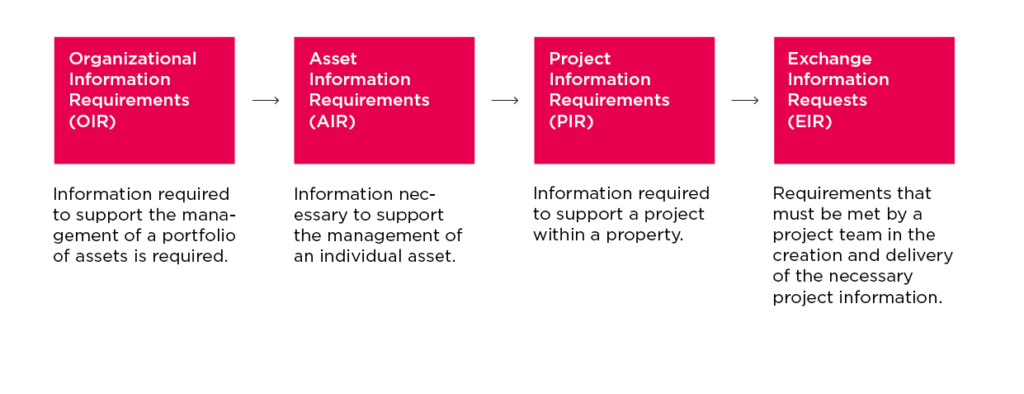ISO 19650 for the BIM planing
International standards for information management using BIM
Part 3
In this part of our series on LOD, we look at the international standards for information management using BIM, the EN ISO 19650 series. This expands our discussion from an object and model-based focus to a broader view of information management from an organizational and project perspective. The first two parts of the LOD series deal with the basics and the features of the LOD specification.
The series at a glance
- Part 1: Basics of LOD
- Part 2: Features of the LOD specification
- Part 3: ISO 19650 for the BIM planing
- Part 4: From LOD to LOIN
- Part 5: Data templates as final puzzle piece for model-based work
Introduction of ISO 19650
ISO 19650 Parts 1 and 2, both published in December 2018, provide a framework for defining information requirements and project management processes from two perspectives. First, we have the client (EN: “Appointing Party”), usually a property owner or developer, who provides the information requirements. On the other hand, we have the contractors (EN: “Appointed Party”), the project team responsible for creating and delivering the project information during the planning, construction and/or operation of a property.
Without going into too much detail, we will give a brief introduction to some of the key concepts around the ISO 19650 series.
According to the principles of ISO 19650-1, information requirements should be defined at certain levels in a top-down cascade. First, clients define their information needs at a general organizational level; for example, the definition of the information needed to manage their portfolio of properties. These are the so-called Organizational Information Requirements, OIA (EN: Organizational Information Requirements, OIR). Individual property information requirements, LIA (EN: Asset Information Requirements, AIR), must be defined for each property within this portfolio. Each property can be linked to one or more projects (e.g. a new building, a renovation or extension, or a demolition). For each of these “projects” within a property the Project Information Requirements, PIA (EN: Project Information Requirements, PIR) are defined.
From the outset, clients should define the “purpose” or business processes that are relevant to them to manage their construction projects at all levels: organization, property and project. Second, clients need to know the information needed to support these business processes. This puts the clients in a better informed position to demand specific information requirements from the project team.
These activities take place within an organization and may not be directly visible to a project team. In order to assign a project team (contractor), the client must define certain information services. What can be called a project specification in traditional projects and a BIM specification in BIM projects is called Exchange Information Requirements, AIA (EN: Exchange Information Requirements, EIR) in ISO 19650-1. In Germany this is also known as the client information requirements. These are contractual requirements that define how project information is to be created, exchanged, quality checked and, above all, delivered. AIAs are usually provided at the time of the project call for proposals to instruct the project team what information to provide to meet the contractual requirements.

This may sound quite complex, whatever it is. Basically, it describes how information needs should ideally be defined for all projects, not just BIM projects. Let’s take a step back and look at a practical example to illustrate this.
In the example, the client is a real estate company. One of its core business processes is the leasing of commercial space. To support the rental management (in this case the “purpose”) the owner needs to know the total rental space of his various properties. There are many other parameters that are of interest to the owner, such as what space is currently rented and at what price per square meter. These are all organizational and asset-related information requirements that support the individual business process. The project team (general planner or general contractor) provides only part of this information. In this case, the owner asks the project team to provide a digital building model containing room definitions with key figures of the net floor space for each room. The square meter prices and information on tenant occupancy come from a different source.
At the heart of this whole process we are talking about information management. More specifically, we are talking about information requirements to support specific processes. These processes can be business processes, such as the management of rental space, or planning processes, such as the simulation of heating and cooling capacity. In both cases, determining the level of information to be exchanged or supplied is essential to support the relevant processes.
With the scale conventions and even the BIM convention of LOD, we only had a very approximate way to define the information to be delivered. ISO 19650-1 attempts to make this more precise by identifying specific exchange requirements for individual use cases or processes. For this purpose, ISO 19650-1 introduces the term Level of Information Need or LOIN. The concept of LOIN is the topic of our next article in this series.

Mark Baldwin
Author and BIM expert, Managing Director of Digital Insights GmbH and co-director of the Digital Construction course at the Lucerne University of Applied Sciences and Arts.


